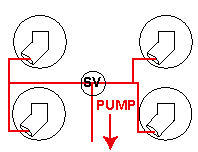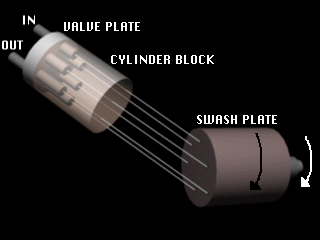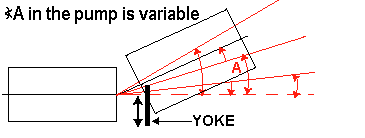 |
|||||
| Home | Research | For Teachers | HISTORY Level 1 Level 2 Level 3 |
PRINCIPLES Level 1 Level 2 Level 3 |
CAREER Level 1 Level 2 Level 3 |
| Gallery | Hot Links | What's New! | |||
| Web Administration and Tools | |||||
 |
|||||
| Home | Research | For Teachers | HISTORY Level 1 Level 2 Level 3 |
PRINCIPLES Level 1 Level 2 Level 3 |
CAREER Level 1 Level 2 Level 3 |
| Gallery | Hot Links | What's New! | |||
| Web Administration and Tools | |||||
![]()
A hydraulic motor is a device that generates rotary motion directly from the hydraulic system. An example of this is a 4-wheel drive system.

To change the hydraulic pump into a hydraulic motor, several changes need to be made. One of these changes is putting a gear box on the shear shaft (see section 1.8-Aircraft Hydraulic System Power Pumps).
Hydraulic motors give a steady, continuous torque. They are small and compact.
When the hydraulic pump is connected to a selector valve, the hydraulic oil coming into the pump pushes down on the pistons, causing the whole piston assembly to rotate. If this assembly is connected to a shaft, the shaft will rotate with great rotational speed.

The Vickers Hydraulic Motor has a gear reduction box which is attached to the pump to reduce the rotational speed to a useable range. When a system's energy is conserved, input torque x input rotational speed = output torque x output rotational speed. If there are no energy losses in the pump and we decrease the rotational speed, we increase the torque generated.


The rotation of the motor lowers the winch
Variable displacement pumps work by having the pump side at an angle to the horizontal. The movement of the pistons within the pump will draw hydraulic fluid into (or expel fluid out of) the pump. The amount of fluid drawn into (or expelled out of) the pump will depend upon the angle the pump makes with the horizontal. The pump could be controlled by a yoke that moves the pump to different angles, thus varying the pump displacement.

Send all comments to ![]() aeromaster@eng.fiu.edu
aeromaster@eng.fiu.edu
© 1995-98 ALLSTAR Network. All rights reserved worldwide.
Updated: February 17, 1999